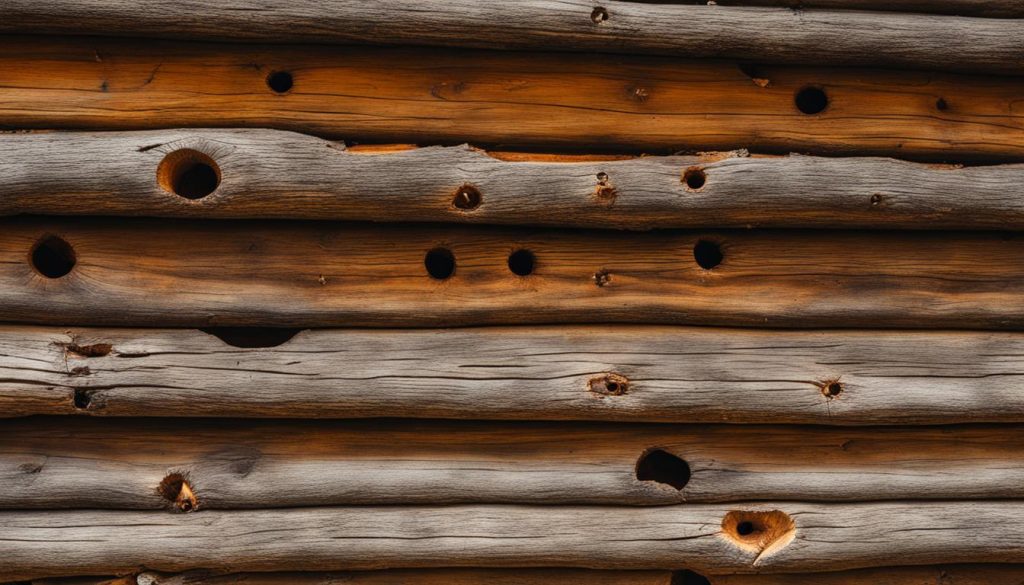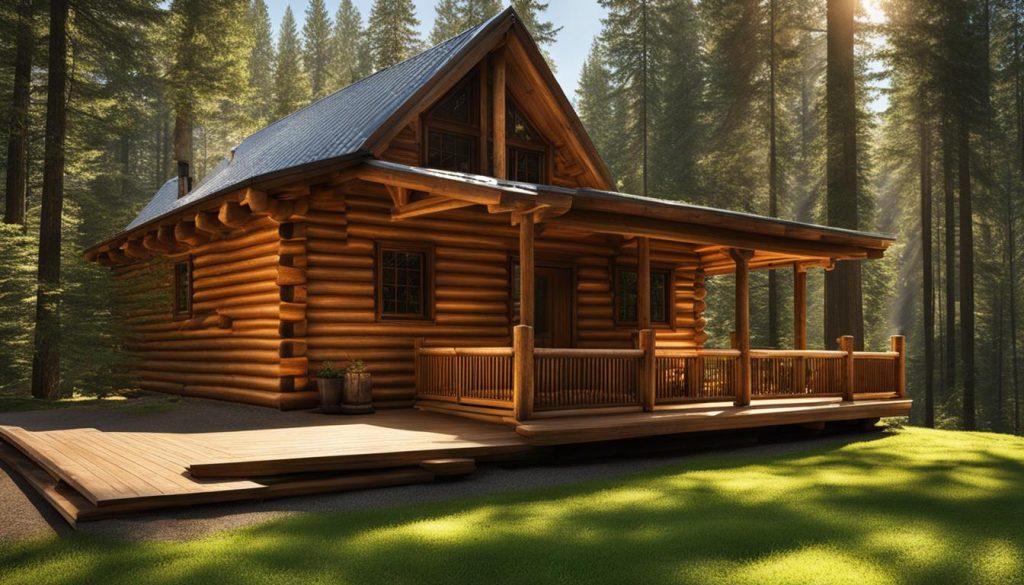
Essential Maintenance Tips for Your Log Cabin
Hello, and welcome to my article on log cabin maintenance. As a log cabin owner, it’s important to prioritize the care and preservation of your cozy retreat. Regular maintenance can help you avoid costly repairs and ensure that your log cabin remains in pristine condition for years to come.
In this article, I’ll share essential tips and guidance on log cabin maintenance, covering everything from cleaning and repairs to refurbishment and renovation. Whether you’re new to log cabin care or an experienced owner, I’m confident you’ll find valuable insights to help you keep your log cabin looking its best.
Throughout this series, we’ll explore topics such as log cabin cleaning, preservation, restoration, repairs, upkeep, and even refurbishment and renovation. By delving into each area of log cabin maintenance, you’ll gain a comprehensive understanding of the steps needed to ensure the longevity and beauty of your log cabin.
So, let’s dive in and discover the tips and tricks for maintaining your log cabin. With a little effort and regular upkeep, you can continue to enjoy the unique charm and warmth that only a log cabin can provide.
Common Log Cabin Maintenance Issues
Maintaining a log cabin comes with its own unique set of challenges. In order to ensure the longevity and beauty of your log cabin, it’s important to address common maintenance issues. The most frequent issues faced by log cabin owners include moisture damage, insect and animal damage, and sunlight damage.
Moisture Damage
Moisture can be detrimental to the integrity of your log cabin. It can lead to mold, mildew, and rot, compromising the structural stability of the wood. To combat moisture damage, it’s crucial to implement proper moisture management practices. This includes diverting water away from the foundation through effective landscaping, regular maintenance of rain gutters to prevent leaks, and sealing any areas prone to water intrusion.
Insect and Animal Damage
Pests such as beetles, termites, carpenter ants, carpenter bees, and woodpeckers can wreak havoc on your log cabin. These creatures can cause damage to the wood, leading to structural issues. To prevent and address pest infestations, it’s important to keep the area around your cabin free from dead or rotting wood, utilize pest control products, install deterrents for woodpeckers, and conduct regular inspections to identify and resolve any pest issues promptly.
Sunlight Damage
Sunlight can cause significant damage to the wood in your log cabin, including discoloration, cracking, and warping. Applying a reliable log home wood stain can provide protection from harmful UV rays. It’s essential to regularly stain and seal the exterior of your log cabin to minimize sunlight damage. Additionally, creating outdoor shade using plants and landscaping can help reduce the direct exposure of your log cabin to sunlight.
By addressing these common log cabin maintenance issues, you can prevent costly repairs and ensure the longevity of your log cabin. Regular maintenance and proactive measures are key to preserving the natural beauty and structural integrity of your log cabin for years to come.
Tips for Managing Moisture in Your Log Cabin
Managing moisture is crucial to protect the integrity of your log cabin. Excess moisture can lead to mold, mildew, and rot, compromising the structural integrity of your home. To prevent these issues, follow these essential tips for managing moisture in your log cabin:
1. Log Cabin Landscaping
A well-designed landscape can help divert water away from your log cabin’s foundation. Ensure that the ground slopes away from your cabin, directing water to flow away. Consider adding gravel or mulch to absorb excess moisture and prevent water from pooling around the base of your cabin.
2. Log Cabin Rain Gutter Maintenance
Proper maintenance of your log cabin’s rain gutters is essential for managing moisture. Regularly clean out any debris, such as leaves and twigs, to ensure that water can flow freely. Check for any leaks or damage that could cause water to seep into the cabin. Additionally, consider installing gutter guards to prevent clogs and protect your cabin from water damage.
3. Log Cabin Sealing
Sealing your log cabin is crucial to prevent moisture from penetrating the wood. Regularly inspect the caulking and sealant around windows, doors, and other openings. Replace or repair any damaged or deteriorated seals to maintain a watertight barrier. Additionally, apply a quality wood sealer or stain to protect your logs from water absorption and UV damage.
By implementing these tips, you can effectively manage moisture in your log cabin, ensuring its long-term durability and beauty. Remember to conduct regular inspections and address any moisture issues promptly to protect your investment.

| Moisture Management Tips | Benefits |
|---|---|
| Proper landscaping | Diverts water away from the cabin’s foundation |
| Rain gutter maintenance | Prevents water buildup and potential leaks |
| Log cabin sealing | Protects the wood from moisture absorption |
Preventing Insect and Animal Damage to Your Log Cabin
Log cabins are known for their rustic charm and natural beauty. However, they are also susceptible to damage from pests such as beetles, termites, carpenter ants, carpenter bees, and woodpeckers. These unwanted guests can wreak havoc on your log cabin, causing structural damage and compromising its integrity. It is essential to take proactive measures to prevent and address these pest infestations.

Log Cabin Pest Control
When it comes to log cabin pest control, prevention is key. Here are some effective strategies:
- Keep the area surrounding your log cabin clean and free from debris, including dead or rotting wood. Pests are attracted to decaying organic matter.
- Seal any gaps or cracks in your log cabin’s exterior to prevent pests from finding their way inside.
- Use pest control products specifically designed for log cabins, following the instructions carefully to ensure safe and effective application.
- Regularly inspect your log cabin for signs of pest activity, such as chewed wood or droppings, and take immediate action if any issues are detected.
Log Cabin Woodpecker Prevention
Woodpeckers can cause significant damage to log cabins, pecking holes in the wood and creating entry points for other pests. Here are some tips to prevent woodpecker damage:
- Install woodpecker deterrents, such as visual repellents or reflective tape, near areas where woodpeckers are active.
- Hang wind chimes or use other noise-making devices to deter woodpeckers from approaching your log cabin.
- Consider applying a taste deterrent to the exterior of your log cabin to make the wood less appealing to woodpeckers.
By following these log cabin pest control and woodpecker prevention tips, you can protect your log cabin from unwanted guests and preserve its natural beauty for years to come.
Protecting Your Log Cabin from Sunlight Damage
Sunlight can be both a blessing and a curse for log cabins. While it provides warmth and natural light, it can also cause significant damage to the wood over time. Exposure to UV rays can lead to discoloration, cracking, and warping, compromising the structural integrity and aesthetic appeal of your log cabin. Therefore, it is crucial to take proactive measures to protect your log cabin from sunlight damage.

Regular staining and sealing: One of the most effective ways to shield your log cabin from sunlight damage is by regularly staining and sealing the wood surfaces. A high-quality log home wood stain not only enhances the natural beauty of the wood but also provides a protective barrier against UV rays. It is recommended to choose a stain that offers UV protection specifically to safeguard the log cabin from sun damage. Prioritize using exterior-grade products suitable for log cabins, as they are designed to withstand the elements and provide long-lasting protection.
Creating outdoor shade: Another strategy to minimize sunlight exposure is by creating natural shade around your log cabin. Planting trees strategically can help cast shadows and reduce the amount of direct sunlight that reaches the wood surfaces. Additionally, consider incorporating outdoor structures like pergolas or awnings to provide additional shade and protection. These features not only enhance the visual appeal of your log cabin but also serve as a practical solution to mitigate sunlight damage.
Practicing good log home maintenance: Regular maintenance is essential for the longevity of your log cabin. By following a comprehensive log cabin exterior maintenance routine, you can minimize the impact of sunlight damage. This includes inspecting the wood surfaces for signs of wear or damage, promptly addressing any issues, and performing routine cleaning and maintenance tasks. Regular cleaning helps remove dirt, debris, and any substances that may contribute to sun damage, keeping your log cabin in optimal condition.
Conclusion
Protecting your log cabin from sunlight damage is crucial to preserve its beauty and extend its lifespan. By taking proactive measures such as regular staining and sealing, creating outdoor shade, and practicing good log home maintenance, you can shield your log cabin from the harmful effects of UV rays. Remember, maintaining your log cabin’s exterior is an investment that will pay off in the long run by ensuring the durability and allure of your beloved home.
Conclusion
As I conclude this article on log cabin maintenance, I hope you have gained valuable insights on how to take care of your precious investment. By following these log cabin maintenance tips, you can ensure the longevity and appeal of your home for years to come.
Maintaining a log cabin requires diligence and regular upkeep, but the effort is well worth it. With proper moisture management, pest control measures, and protection against sunlight damage, you can prevent costly repairs and preserve the beauty of your log cabin.
Remember, your log cabin is not just a house; it’s an investment in a unique living space that deserves attention and care. By implementing these maintenance practices, you can protect your log cabin and enjoy its charm for generations to come.